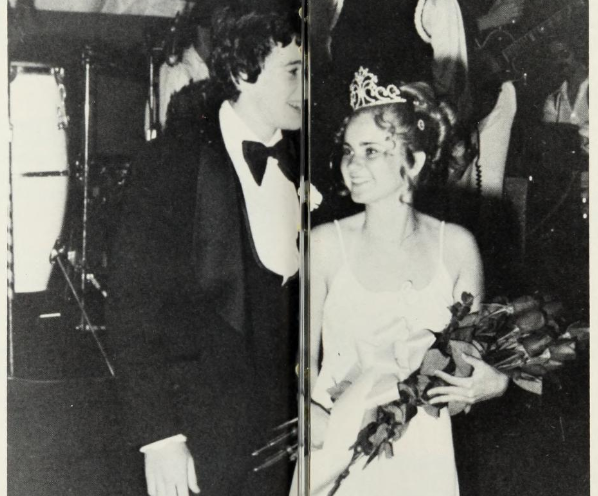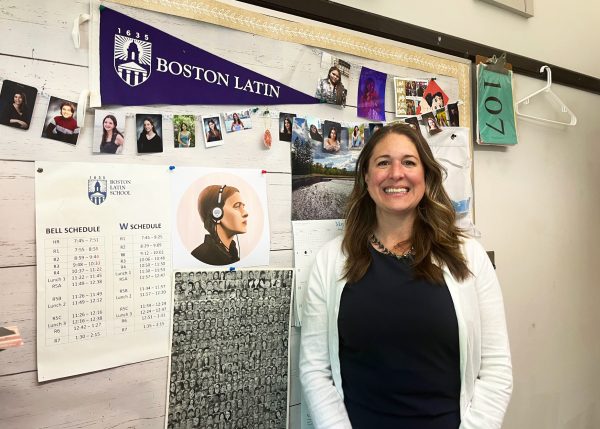W for Women: Fifty Years of a Co-Ed BLS

Barbara Macniel was BLS’s first prom queen. (Photo Credit: 1978 Yearbook)
With this year marking the 50th anniversary since young women first entered Boston Latin School, the School has commenced celebrations to honor this milestone for the female community.
On November 19, 2022, the school commemorated the occasion at the BLS Alumni Celebration with a video. The video highlighted the history leading up to the integration of co-ed classes in Boston Public Schools, as well as the experiences of the first female students.
The fight for co-ed classes at BLS took almost a century. In 1877, the Massachusetts Society for the Education of Women first petitioned the Boston School Committee to allow girls to attend BLS (formerly known as Boys’ Latin School). The inclusion of girls at BLS did not begin until 1972, when the Massachusetts Legislature passed a bill banning sex-based discrimination in public schools. In the same year, BLS’s sister school, Boston Latin Academy (formerly known as Girls’ Latin School), also became co-ed, with ten boys enrolling.
This integration, however, was not met with positivity — instead, heavy controversy surrounded the change.
Jean Sorrentino (‘78) reflects, “My two older brothers would take me to school […] and they made me walk behind them and pretended not to know me because they had been indoctrinated by school administration that when girls come, they would ruin this fine institution.”
In addition to the dissent toward incorporating female students to BLS, the School itself was also not prepared for this transition. On the first day, the registrar’s office had not yet created schedules for girls, there was only one girls’ restroom and no girls’ locker rooms. Girls also made up a small portion of this new class, with only 45 of them in the entering sixie class; as such, each classroom contained only two or three girls.
The general environment at the School was not initially supportive of girls. BLS math teacher Ms. Tracy O’Donnell (‘81), who was a member of the School’s first co-ed classes, explains, “There was a time where the boys would tease us all the time, and it wasn’t discouraged by the teachers.”
Female students constantly had to prove that they belonged in the institution because of the School’s lack of inclusivity.
Despite the pushbacks, girls would soon find themselves connecting through sports teams. In previous years, cheerleaders from BLA would cheer on BLS’s football team, but that was no longer the case. They instead became part of the first girls’ volleyball and basketball teams for girls in the School’s history. Becoming a part of the school community through these teams and other extracurriculars helped create the tight-knit community this graduating class has held for many years.
Five decades have now passed, with BLS making strides in providing students with a more welcoming environment. The School is now composed of 52-percent female-identifying students, and has hired a more diverse range of teachers, compared with the School having only three female faculty members back in 1972.
Winnie Yuan (I), president of BLS Ladies’ Collective says, “There are also a lot of women-teachers at BLS as well […] and then, with students, I would say, there’s a really diverse gender representation at BLS.”
In 1998, Cornelia Kelley became the School’s first female Head of School. 19 years later, BLS inducted former Head of School Rachel Skerritt (‘95) as its first female leader of color. During her term, the dress code, which previously had rigid restrictions on what girls could wear, was modified.
Even with these advancements, students remain hopeful for a future that emphasizes intersectionality.
Sarah Dienta (I),president of BLS Young Women of Color, says, “I also came in as a B-sie. So when it was already hard enough to be integrated, and I feel like it was just also that much harder because I was a woman of color.”
Many of these challenges and experiences of discrimination are unique for everyone. Girls of color at BLS may have had a different experience compared with other girls, so it is important to address all perspectives of these narratives.
The significance of the role of girls at BLS throughout the past 50 years should not be ignored. As school nurse Ms. Ellen Moy-Maniekis (‘78) concludes, “If you don’t celebrate history, that history gets lost.”






